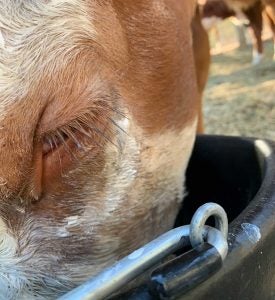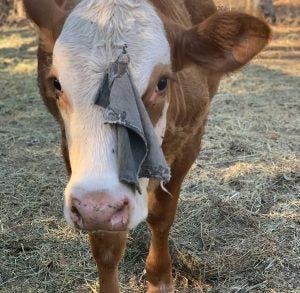I purchased three heifers on Mother’s Day weekend. Not long after that, one began coughing, and as a new rancher, I was paranoid about respiratory disease. I knew that they had been vaccinated but was informed that issues may still arise and to have a watchful eye — which is exactly what I did once my one heifer started coughing. After a few days went by, I decided it would be a good idea to treat her with LA 200, an antibiotic known as oxytetracycline, in order to make sure she hadn’t picked up anything from being at the stockyards. I went to my local feed store and realized they didn’t have any type of antibiotic on the shelf. I then remembered the livestock antibiotic law passed in California in 2017. The Livestock Antibiotic Rules state:
“Effective January 1st, 2018, a prescription from a California licensed veterinarian (within a valid veterinarian-client-patient relationship [VCPR]) is required for the use of all medically important antibiotics in California livestock. These include all antibiotics for which a prescription is currently required (Excede, Nuflor, Draxxin, etc.), plus a few others, like penicillin (PPG) and oxytetracycline (LA-200, -300, Biomycin, etc.), that were previously purchased over-the-counter.”
I realized at this point that I would need a veterinarian to give me a prescription in order to treat my heifer. However, I didn’t have a VCPR, since I was new in the area. When I contacted the area vet, I had a bad experience over the phone, which ultimately led to me to decide to watch my heifer for a few more days while I looked into other options for her care. Thankfully, her cough ended up being caused by allergies and dust, and I no longer needed a vet to check on her.

However, shortly afterward, she injured her eye and needed some doctoring. Again, I watched her for a few days, cleaned out her eye, and treated her for flies before determining she needed more medical attention. This time, instead of calling another veterinarian, I was able to have a rancher, who lives down the road from me, offer to look at her. When he saw her injury, we treated her with LA 200, Banamine, and an eye ointment. A week later she was fully healed and doing great.
Even though I am new to the ranching side of the industry, I have been having the antibiotic controversy discussion since I began advocating in agriculture. The importance of keeping antibiotic resistance at bay is not one to be understated. I understand the concerns of those who don’t want livestock to be excessively treated with antibiotics that are medically important in humans.
Because some antibiotics are used in both humans and livestock, the Food and Drug Administration worried that antibiotic resistant bacteria could lead to super bugs.
Since the law, by the FDA, went into effect in 2018, most common over-the-counter medication was removed from the shelf, and all livestock antibiotics will need a veterinarian’s prescription, under a Veterinary-client-patient relationship, by 2023.
The rules of a VCPR, according to the California Department of Food and Agriculture website, states:
- “It is the veterinarian’s obligation to establish a VCPR before practicing veterinary medicine, unless the patient is a wild animal or the owner is unknown (16 CCR § 2032.1).
- While in general, telemedicine is permissible within an existing VCPR, the Veterinary Medical Board is on record that it is below the acceptable standard of care to establish a VCPR over the phone or by means of an electronic device. In an emergency care situation, advice may be given telephonically or by other electronic means until the patient can be seen by or transported to a veterinarian.
- The criteria that must be met in order to establish a valid VCPR include (16 CCR § 2032.1):
- The client has authorized the veterinarian to assume responsibility for making medical judgments regarding the health of the animal, including the need for medical treatment:
-
-
- The veterinarian has sufficient knowledge of the animal(s) to initiate at least a general or preliminary diagnosis of the medical condition of the animal(s). This means that the veterinarian is personally acquainted with the care of the animal(s) by virtue of an examination of the animal, or by medically appropriate and timely visits to the premises where the animals are kept, and
- The veterinarian has assumed responsibility for making medical judgments regarding the health of the animal and has communicated with the client a course of treatment appropriate to the circumstance.”
-
On the bright side, antibiotic use is down 33 percent, which is a great feat that demonstrates the constant improvement in genetics and general care of livestock.

An important note: Any livestock given antibiotics are removed from the food chain process until the withdrawal period is over. This means the drugs pass through their system and aren’t at risk of getting caught in the food chain.
With discretion, being able to treat our sick animals is part of ensuring they produce well and are happy. Because the vet I called wasn’t willing to see my animals in a timely manner, my heifer might have been sick for almost six days before being looked at. However, with the ability for me to grab the medication and supplies, I could have had her treated within a matter of hours.
I think it’s necessary to be educated on the judicial use of antibiotics in food animals, but it’s also important to understand how access to the right medication at the right time can mean the difference between a healthy, happy animal, or a stressed, sick animal. It’s a hard lesson to learn as I realize the growing regulations and restrictions placed on vital resources in the ranching community.
Markie Hageman lives in California and is an agribusiness graduate from Fort Hays State University. She is the Communications Coordinator for California Rangeland Trust and is an avid agriculture advocate. Her AGDAILY articles can be found here.



